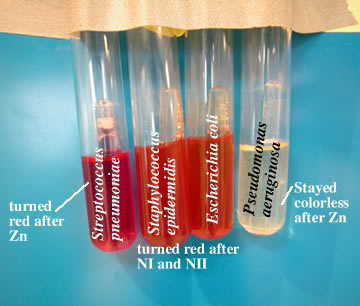This is a differential medium. It is used to determine if an organism is capable of reducing nitrate (NO3-) to nitrite (NO2-) or other nitrogenous compounds via the action of the enzyme nitratase (also called nitrate reductase). This test is important in the identification of both Gram-positive and Gram-negative species.
After incubation, these tubes are first inspected for the presence of gas in the Durham tube. In the case of nonfermenters, this is indicative of reduction of nitrate to nitrogen gas. However, in many cases gas is produced by fermentation and further testing is necessary to determine if reduction of nitrate has occurred. This further testing includes the addition of sulfanilic acid (often called nitrate I) and dimethyl-alpha-napthalamine (nitrate II). If nitrite is present in the media, then it will react with nitrate I and nitrate II to form a red compound. This is considered a positive result. If no red color forms upon addition of nitrate I and II, this indicates that either the NO3- has not been converted to NO2- (a negative result), or that NO3- was converted to NO2- and then immediately reduced to some other, undetectable form of nitrogen (also a positive result). In order to determine which of the preceding is the case, elemental zinc is added to the broth. Zinc will convert any remaining NO3- to NO2- thus allowing nitrate I and nitrate II to react with the NO2- and form the red pigment (a verified negative result). If no color change occurs upon addition of zinc then this means that the NO3- was converted to NO2- and then was converted to some other undetectable form of nitrogen (a positive result).
If the nitrate broth turns red (tubes pictured in the center) after nitrate I and nitrate II are added, this color indicates a positive result. If instead, the tube turns red (tube pictured on the left) after the addition of Zn, this indicates a negative result. If there is no color change in the tube after the addition of nitrate I and nitrate II, the result is uncertain. If the tube is colorless (picture on the right) after the addition of Zn this indicates a positive test.
 9:11:00 AM
9:11:00 AM Dr. Kazi Abdus Sobur
Dr. Kazi Abdus Sobur Bacteriology, Microbiology
Bacteriology, Microbiology No comments
No comments
Subscribe to:
Post Comments (Atom)




0 Comments:
Post a Comment